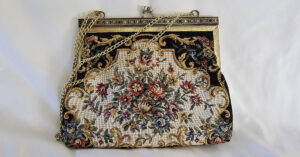 KT doesn’t know it, but she owns a 1930s ladies evening bag in the tradition of 17th century Viennese petit point. This style of needlework originated with the early French Court as a pastime for Royal women. As they discovered the Chinese style of needlework during the 17th century, the Petit point stitch became finer, the threads thinner, colors more sophisticated.
KT doesn’t know it, but she owns a 1930s ladies evening bag in the tradition of 17th century Viennese petit point. This style of needlework originated with the early French Court as a pastime for Royal women. As they discovered the Chinese style of needlework during the 17th century, the Petit point stitch became finer, the threads thinner, colors more sophisticated.
During the 1700s needlewomen discovered the delicacies of Dutch landscape and still life works of art. They embroidered these compositions on bags. They used petit point on handbags, compacts, purses, and bijouterie (jewelry pouches). Bags featured scenes in vibrant wool thread of court scenes, pastorals, gardens, floral sprays, mythological figures, and courting couples. In the late 18th, 19th and 20th century, they stretched needlework over metal purse frames with clasps, with accents of jet, or marcasite, or semi-precious stones.19th and 20th century bags featured silk linings, and sometimes they signed it with the place of manufacture. In FT’s case, the interior says, “Made in China” which means made post 1915. It MIGHT be handsewn. Machine looms took over the role of a trained needlewoman in the 20th century.
Fine European or Chinese Needlework
A fine European or Chinese HANDMADE purse by an accomplished needlewoman contained nine-hundred stitches to the square inch in a style called a tent stich. They fashioned bags out of other styles of needlework as far back as the 12th century in Europe, such as tapestry, turkey, crewel, Berlin, cross stitch, and tambour work. Needlework became the favorite decoration, as they considered a bag holding something precious a status symbol, meant to be admired.
WHY did it become a status symbol? That’s an interesting story. Society expected high born men to give to the poor on their estates. They wore a special leather pouch that contained coins, worn outside their garments to show they gave money freely. They appropriately called this bag an “Almonier” as in “Alms for the Poor.” High born ladies adopted the style and added elements of textile art, beadwork, and metals.
During the late Medieval period men also carried bags containing important documents designed with Royal portraits or state seals worked on the front. When a courtier wanted a Royal favor, he might present one of these custom made bags to royalty with a small bribe inside. This style developed through the 14th century in England.
In the late Medieval period in Europe ladies wore bags long, reaching to knees or ankles. Those bags carried necessary small objects.
NAMES of Bags
Through the ages people used many names for bags: reticule, gipser, minandier, portemonnaie, purse, and necessaire. My favorite style of bag they call a chatelaine, not really a bag at all. The earliest chatelaine, usually silver and decorative, appeared in France in the 15th century. The chatelaine hung from a belt with a decorative clasp which suspended at least eight chains with hooks to hold necessary objects: sewing tools, writing implements, a small coin purse, a match safe to keep matches dry. The chatelaine had a special hook for keys to the house cupboards. The lady of the house locked many goods against thieving servants.
By the 16 century the style of the huge hoop skirt or Farthingale allowed for interior pockets inside those voluminous skirts for necessary objects. For a hundred years the purse went out of style. As the female silhouette decreased in the 17th century, they used bags as status symbols to carry small necessities, such as smelling salts and perfume. The reticule came back in vogue.
The wedding bag worn by the bride with a portrait of her and the groom painted on porcelain and applied to fabric became a favorite purse in the 17th century
Chinese needlework is important to the development of the textile handbag. A kind of stitch in China for bags and clothing of the Court was so fine that it became known for causing blindness. That “forbidden stitch” became illegal. The French in the 17th century became skilled with this stitch and called it Tambour work, embroidery done with a tiny hook to create a chain links of threads, imported through Europe.
KT’s little Chinese bag, if handstitched, is worth $250. If machine embroidered it’s worth $100.
I have one of these! It was my grandmother’s. I inherited a lot of her evening bags she carried during the Roaring ’20’s and 1930s. Lovely to know the history of the textile bag. Thank you!